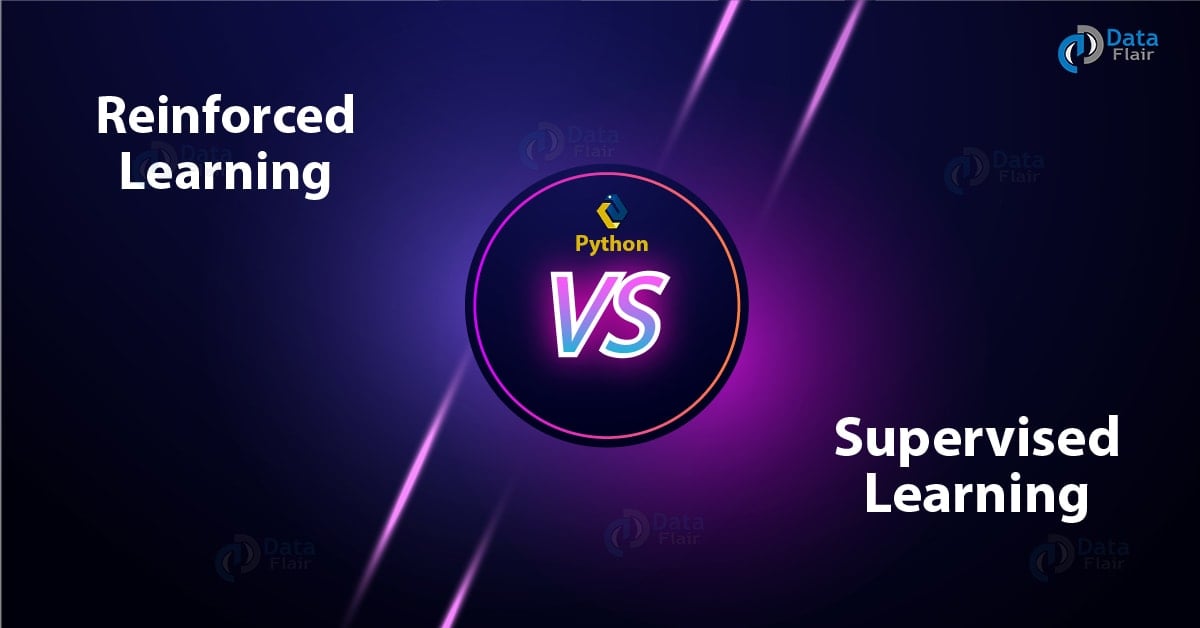Reinforcement Learning With Python – AI
Free Machine Learning courses with 130+ real-time projects Start Now!!
Python course with 57 real-time projects - Learn Python
So far, we’ve been on some kind of journey with Artificial Intelligence using Python. Today, we will delve a little into Reinforcement Learning with Python. Moreover, we will discuss factors, types, and example of Reinforcement Learning with the example.
Also, we will see a comparison of Reinforcement Learning vs Supervised Learning. At last, we will see the applications of Reinforcement Learning with Python.
So, let’s start Reinforcement Learning with Python Tutorial.
What is the Reinforcement Learning?
This is an area of Machine Learning where we care about how software agents act in an environment to maximize an idea of cumulative reward. We also call this Approximate Dynamic Programming or Neuro-Dynamic Programming when talking about operations research and control literature.
How this differs from supervised learning, though, is that this doesn’t need correct input/output pairs and we don’t need to correct its sub-optimal actions. We focus on performance by managing a balance between exploration and exploitation. And since there’s no training data set, it learns from experience.
Factors in Reinforcement Learning with Python
The following parameters factor in Python Reinforcement Learning:
- Input- An initial state where the model to begin at
- Output- Multiple possible outputs
- Training- The model trains based on the input, returns a state, and the user decides whether to reward or punish it
- Learning- The model continues to learn
- Best Solution- The maximum reward decides that
Types of Reinforcement Learning with Python
We broadly observe two kinds of reinforcement in Python:
a. Positive Reinforcement Learning
Whenever certain behavior sets off an event, this strengthens the behavior and reduces its infrequency. Say it affects the behavior positively. This has the following benefits:
- Optimization of performance
- Sustenance of change for long
It also faces an issue:
- Too much reinforcement may overload state and lead to diminished results
b. Negative Reinforcement Learning
If we stop a negative condition, this strengthens the behavior leading to it. This is negative reinforcement and it has the following advantages:
- Provision of defiance to minimum performance standard
- Improvement of behavior
And like positive reinforcement learning, this has a disadvantage too:
- There is only enough to meet the minimum expected behavior
Reinforced Learning vs Supervised Learning
We mentioned in section 2 that these are two different things. Now let’s see how.
a. Decision Making
Reinforcement learning is concerned with making decisions sequentially. So, the output depends on the current input and the next input depends on the output of the previous input.
Supervised learning, however, involves making all decisions on the initial input.
b. Dependency and Labels
Decisions depend on each other in reinforcement learning. Hence, we assign labels to sequences of dependent decisions. In supervised learning, decisions are exclusive of each other, which lets us assign labels to each decision.
c. Examples
An example of reinforcement learning can be a game of Chess, and that for supervised learning can be object recognition. (See, that’s a cat. Now, look at this picture [of another cat]. Can you guess what this is?)
Applications of Reinforcement Learning
This kind of learning, as you would have guessed by now, finds use in an array of use-cases:
- Robotics- for industrial automation
- Machine Learning- for data processing
- Creation of training systems providing custom instruction and materials according to requirements of students
In situations where the system must interact with its environment to collect information about it, RL techniques do great.
Reinforcement Learning With Python Example
Before we bid goodbye, we think we should demonstrate a simple learning agent using Python. In the following example, we implement a cartpole using the gym package and watch it learn to balance itself:
>>> import gym
>>> env=gym.make('CartPole-v0')[33mWARN: gym.spaces.Box autodetected dtype as <class ‘numpy.float32’>. Please provide explicit dtype.[0m
>>> env.reset()
array([ 0.00261226, -0.02941416, 0.01968586, -0.0034146 ])
>>> for _ in range(1000): env.render() env.step(env.action_space.sample())
So, this was all in Reinforcement Learning with Python. Hope you like our explanation.
Conclusion
Hence, in this Python AI Tutorial, we discussed the meaning of Reinforcement Learning. Moreover, we saw types and factors of Reinforcement learning with Python. Also, we understood the concept of Reinforcement Learning with Python by an example.
Furthermore, if you feel any confusion regarding Reinforcement Learning Python, ask in the comment tab.
We work very hard to provide you quality material
Could you take 15 seconds and share your happy experience on Google




